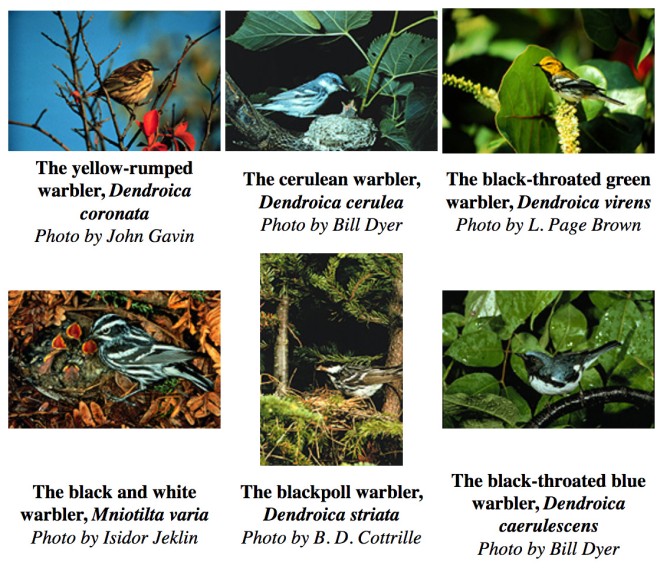'Warbler Watch' on the World Wide Web seeks volunteers to track the northward migration of colorful birds
By Allison Wells
As the wave of brilliantly colored songbirds sweeps northward across the United States and Canada from South and Central America, scientists at the Cornell Laboratory of Ornithology and the National Audubon Society hope thousands of citizen birdwatchers will log-on to the World Wide Web and tell them where the warblers are.
This interactive survey follows the highly successful Cornell-Audubon Great '98 Backyard Bird Count, a web survey that drew nearly 14,000 reports from volunteer bird spotters who made 630,969 sightings in three days in February.
This time the ornithologists are focusing on 51 species of North American wood-warblers, commonly known as warblers, that are considered to be among the world's most beautiful birds as well as long-distance migration champs. By electronically recruiting thousands of volunteer spotters throughout the United States and Canada, the Cornell researchers expect to shed more light on the migratory patterns and breeding habits of the tiny birds, some of which are endangered or threatened species.
"Many of these birds travel thousands of miles nonstop before reaching the Gulf of Mexico and the southern U.S.," says Frank Gill, senior vice president for science at national Audubon. "Species like the bay-breasted warbler, which breeds across the central Canadian boreal forest band and the extreme northern U.S., must continue on for another few thousand miles in order to reach their destinations. With the help of citizen birdwatchers, Warbler Watch will give us more insight into how warblers move across the North American landscape and what kind of reproductive success they are having after they have reached their breeding grounds."
Breeding success is especially important for species like the cerulean warbler, a sky-blue bird that needs large tracts of mature, deciduous forests in the Eastern U.S. and south-central Canada. The cerulean warbler has undergone serious population declines of about 3.8 percent annually since 1966, according to data from National Audubon's Breeding Bird Survey. Other warblers are already considered endangered species due to very limited breeding ranges. The golden-cheeked warbler, for example, breeds only in the old growth woodlands of the Edward's Plateau in central Texas.
Most warblers begin arriving in the U.S. in April, particularly in the Gulf states, according to John Fitzpatrick, director of Cornell's ornithology laboratory. By early May, the numbers and variety of species increase tremendously, and more warblers start appearing farther and farther north.
"The migration of these tiny birds across the globe is an astounding spectacle to watch," says Fitzpatrick. "Consider a bird that's no larger than your thumb finding its way from a remote rainforest in Brazil or Peru to a patch of stunted spruces on an Adirondack peak in upstate New York.
"By analyzing data reported by birdwatchers across the continent," Fitzpatrick adds, "Warbler Watch will help us gain a better understanding of the whole phenomenon of warbler migration. Accumulating an annual archive of these movements will allow us to compare their numbers and migration routes over the years. This information is crucial if we are to ensure a North American landscape that will continue to support these beautiful creatures."
During migration, warblers are likely to be found just about anywhere, from wilderness areas to suburban backyards, city parks, and cemeteries. They often move in large, mixed-species flocks busying about for insects. Known for their distinctive color patterns (combinations of yellow, blue, red, green, black, and white ) and their songs (ranging from musical trills and rich warbles to thin, high-pitched ringing), warblers are relatively easy to locate during a leisurely walk.
"Because warblers, like most other birds, migrate primarily under the cover of night, you might walk your favorite birding path one day and not see any," says Cornell's Fitzpatrick. "The next day, you might see several different warbler species. The effect can seem quite magical."
Would-be warbler watchers can visit http://www.birdsource.org/ and choose the Warbler Watch option. An easy-to-use scroll-down form asks for information, such as the numbers and kinds of species seen, town and zip code of the siting, habitat, and indications of breeding.
The site also provides tips on how to watch warblers, identification marks, conservation status, range maps, and regularly updated animated maps showing which warbler species are being reported and where. Images and examples of each species' song are also on the site. A weekly statistics page will provide numbers of the states reporting the most warblers, the most commonly reported warbler species, and other current information.
"Warbler Watch encourages everybody to rediscover -- or to discover for the first time -- the beauty and importance of warblers," says Gill Audubon's. "The more information we have, the better we will be able to understand and protect these unique and fascinating songbirds."
Get Cornell news delivered right to your inbox.
Subscribe